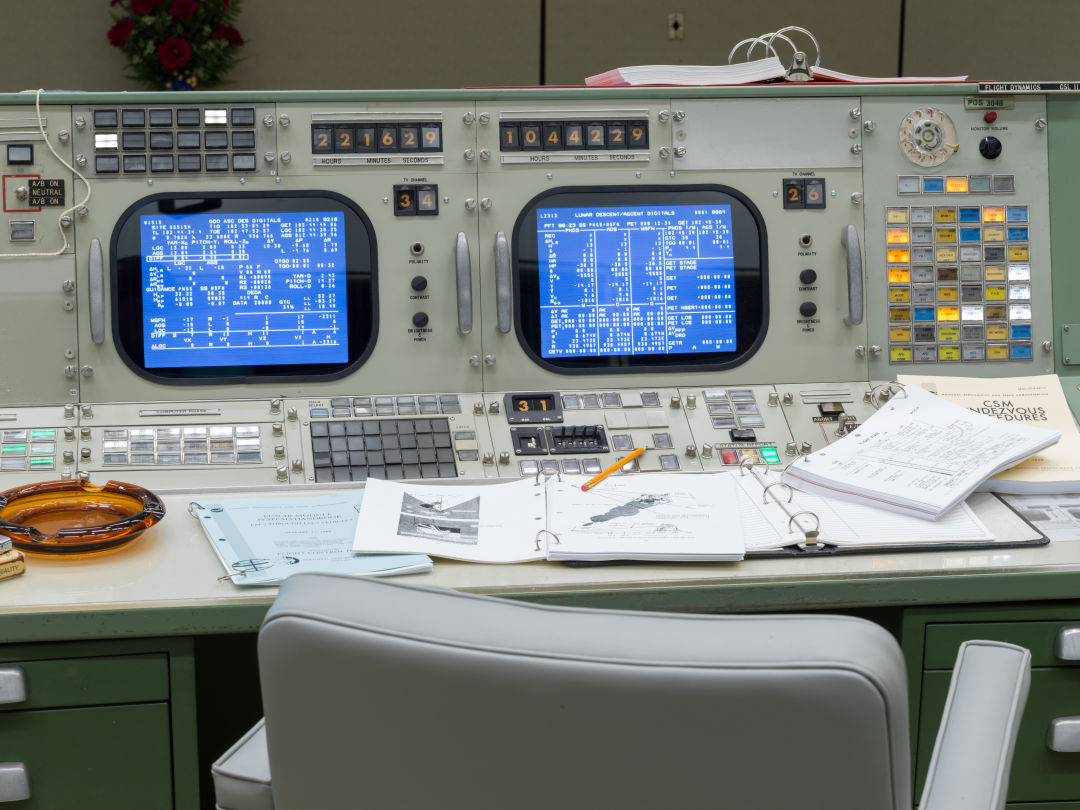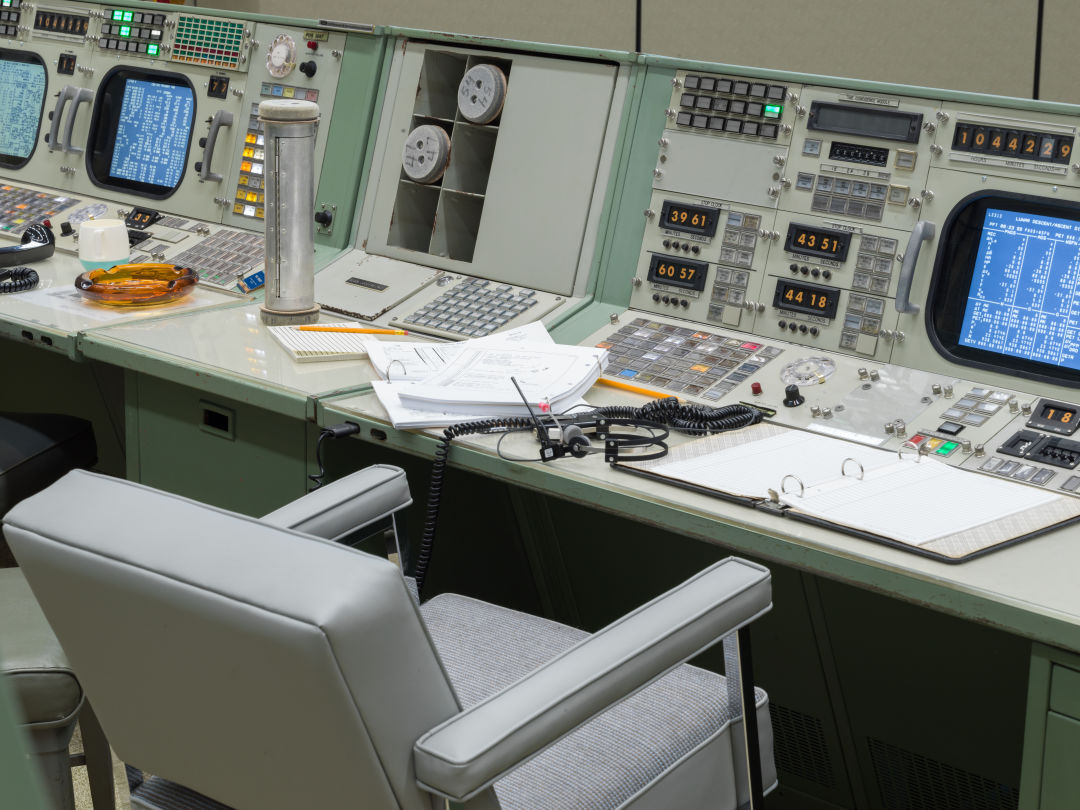How NASA Restored Its Historic Apollo Mission Control Center

The restoration project focused on accuracy, right down to the brand of cigarettes left at each console.
Image: Courtesy NASA
When Neil Armstrong and Edwin “Buzz” Aldrin landed on the moon on July 20, 1969, the flight controllers and engineers at the Apollo Mission Operations Control Room (MOCR) did not technically have eyes on them. That didn’t happen until later, after Armstrong descended the lunar module’s ladder and pulled the handle on a storage compartment that housed the Westinghouse camera inside, activating one of the most famous feeds in history.
During the tension of the landing, NASA staff were glued to their console screens, smoking cigarettes and downing coffee, making critical decisions based on data alone. “We like to tell people that you have more computing power in your phone now than they had in all of mission control,” says Sandra Tetley, a 34-year veteran at Johnson Space Center and the current historic preservation officer. The average age in the MOCR during the Apollo 11 mission, Tetley adds, was just 26.
The moon landing is considered a seminal moment in US (and world) history, a symbol of human achievement and innovation that capped the tumultuous events of the 1960s. Yet in our ever-evolving digital age, it’s easy to forget the magnitude of it all. For years, it was Tetley’s goal to remind us, by restoring the historic Apollo Mission Control Center back to its 1969 heyday—the third such attempt and quite the feat considering just a decade ago there wasn’t much to see.

Help from an Apollo 13 production designer led them to era-appropriate console replicas.
Image: Courtesy NASA
In 1985, Building 30, with its complex of rooms on the third floor that housed mission control, was designated a National Historic Landmark. This was where, from the ’60s into the early ’90s NASA staff oversaw the Apollo program, as well as the Gemini, Apollo-Soyuz Test Project, Skylab programs, and shuttle missions, such as Challenger. By 1992, the Apollo MOCR was decommissioned and its shuttle operations moved elsewhere. “It had basically been abandoned,” Tetley says. “They just turned off the electricity and left it.”
Despite that, the Apollo MOCR still had visitors. The public came through the viewing room on tours, NASA staff hosted VIPs on the floor, and workers simply ate lunch at empty consoles. Neglect and traffic took a toll. The carpet was torn, patched with duct tape, and props, like headsets and slide rules, went missing.
This rankled Eugene “Gene” Kranz, the lead flight director for the Apollo 11 moon landing and leader of the team that successfully saved the Apollo 13 crew. “Mr. Kranz always complained that his abort button was stolen,” Tetley says. “The integrity of that room was actually being lost.”
Then came a bit of serendipity. In 2013, Tetley applied for a $5,000 grant with the National Park Service Heritage Partnership Program to create a video to get visitors excited about the moon landing. Her application caught the eye of the NPS regional director, who instead commissioned a historic furnishings report, hoping it would provide a scope of the work needed to restore the MOCR back to its previous condition.

Screens show realistic displays from July 20, 1969, the original moon landing.
Image: Courtesy NASA
The team conducted a workshop with interested parties, including Apollo flight controllers, and the idea for the restoration crystallized. “[Retired NASA flight controller] Ed Fendell came to the very first workshop in 2014, and he said, ‘We support you a hundred percent,’” Tetley recalls. “He said, ‘It needs to look like we just got up and walked away.’”
But after that, the effort stalled. Part of the logjam stemmed from a jostling for control over the project. The other part: who would foot the $5 million bill. Finally, Kranz had had enough. “He wrote what we call the nuclear letter,” Tetley says.
Dated January 26, 2017, the letter circulated far and wide, including to NASA’s federal preservation officer and US congressional committees, and was accompanied by articles in the Houston Chronicle, with one calling the MOCR “a cathedral in ruin.” The letter finally spurred action. NASA headquarters called Johnson Space Center and told them to get it done, Tetley says.
The city of Webster, home to many of the engineers and flight control personnel employed by the Apollo program, donated $3.1 million, including a $400,000 matching fund. Space Center Houston took the lead for the matching money, launching a 30-day Kickstarter campaign called the Webster Challenge that raised $525,000. Johnson Space Center added another $1 million, and by November 2018 the project was underway. The goal was to finish the restoration by the 50th anniversary of the Apollo 11 moon landing—nine months away in July 2019.
The historic Apollo Mission Control Center actually consists of five rooms, although there’s one that everyone probably pictures first. That would be MOCR, the nexus of decision-making. During the restoration, painstaking steps were taken to identify original finishes for things like paint, wallpaper, and carpet. The team pored over archival photos, but it was the occasional lucky discovery that proved most useful.
After removing a fire extinguisher, they spotted the original wallpaper. The manufacturer still had a roll to reprint. When the consoles and P-tube stations (pneumatic tubes used to send messages between consoles) were moved, the team found the original carpet.
A contractor found and asked the production designer for the 1995 film Apollo 13 how the consoles for the set were so accurately depicted. The designer pointed the team to Cosmosphere, a space museum in Kansas with a restoration division for old tech. Additional ephemera, like mugs and a Rocket coffeepot, Skilcraft binders, even Winston, Philip Morris, Kent, and Marlboro cigarettes that controllers remembered smoking and named in oral interviews, were collected or bought intact off eBay.

Notebooks, slide rules, coffee cups—no detail was missed.
Image: Courtesy NASA
Consoles and the last remaining wall-mounted P-tube station were also restored in the Simulation Control Room, where staff prepare for flight missions. But the Recovery Operations Control Room, where NASA personnel and the navy organize recovery efforts after splashdown, is still in use. A window looking in is instead embedded with a photo of its historical version.
At the front of mission control is the Summary Display Projection Room (nicknamed the “Bat Cave” because it’s painted black), from which maps and images were projected onto the screens in the MOCR. The old tech there has been recreated and, after extensive research, the team nailed down what would have been on those screens during key moments on July 20, 1969.
Photographs of the MOCR often failed to capture the details on the screens. “When the photographers were shooting still photography in there, the mission controllers liked the room to be dark, so when they adjusted their cameras for the lighting, it caused the photos to be grainy,” says Paul Spana, director of collections and curator at Space Center Houston.
Then an archivist found 165 reels of 65mm film at the national archives. The restoration team pieced together the imagery on the MOCR screens and combined it with preserved audio for a complete experience. “It’s like putting a puzzle together,” Spana says of the completed restoration.
At the rear of MOCR, behind glass, the viewing room, where family and dignitaries watched in theater-style seating, also underwent a thorough restoration. An illuminated “Quiet Please” sign remains. Upholstery on the seats was professionally cleaned, the little pop-out ashtrays in the seat backs restored—they’re sometimes mistaken for cell phone holders by a younger generation of visitors.
Now those visitors can hear the audio chatter between the controllers and astronauts, watch the clocks tick down, and see the screens scroll with real data. For a few moments, they relive a history that is not so distant in some ways, but hard to fathom in others. “The historic control room shows you what can be done,” Tetley says. “It shows what humankind is capable of doing.”




